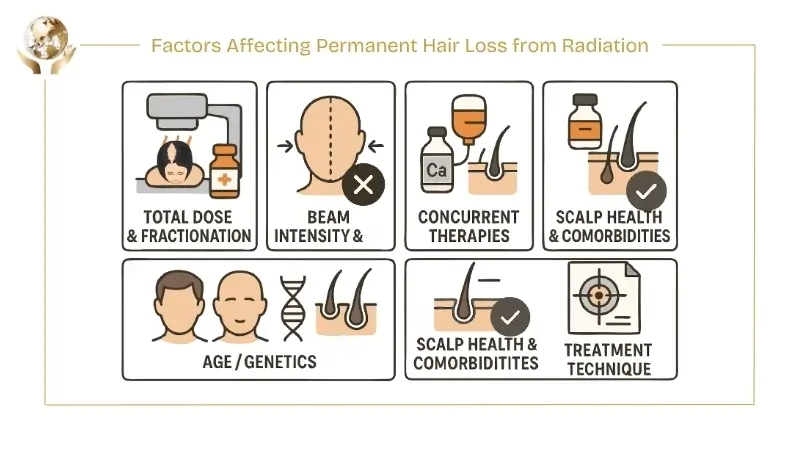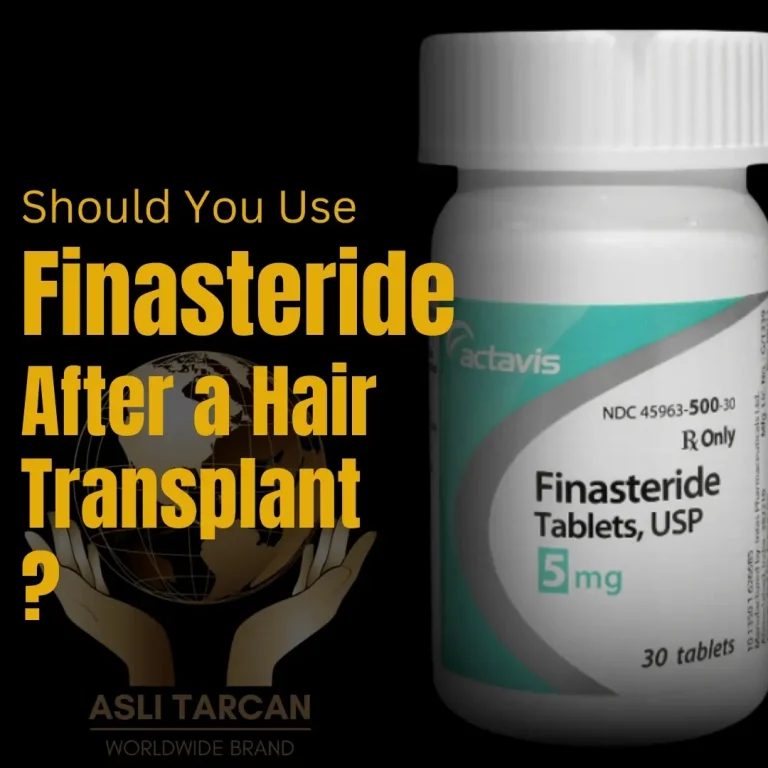What Radiation Dose Causes Permanent Hair Loss?
Understanding what radiation dose causes permanent hair loss is a vital question for patients undergoing cranial, head, or neck radiotherapy.
While radiotherapy targets tumors and aims to spare healthy tissues, hair follicles in the radiation field are often affected. Radiotherapy, as opposed to systemic chemotherapy, causes localized hair loss.
This blog explores the mechanisms behind the follicle damage, defines radiation dose thresholds for permanent vs. temporary loss, and outlines where hair loss typically occurs.
We will also discuss hair regrowth after radiation, compare it with chemotherapy-induced hair loss, and provide protective tips and curative care.
By the end, you’ll understand:
- What radiation dose causes permanent hair loss?
- How to reduce risks
- Timeline and options for recovery
What Is Radiotherapy?
Radiotherapy, commonly referred to as radiation therapy, is a cancer treatment using high-energy radiation to kill the tumor cells.
- External Beam Radiation (e.g., X-rays, gamma rays, protons).
- High precision beam radiators such as Stereotactic Radiosurgery (SRS).
- Brachytherapy in which radioactive sources are inserted within the body.
Most brain cancer treatments use daily doses of 1.8-2 Gy in fractions over weeks (total = 45-60 Gy). These beams are used against the tumor and will inevitably go through the scalp, affecting both skin and hair follicles.
Modern methods such as intensity-modulated radiation therapy (IMRT) and volumetric modulated arc therapy (VMAT) target the radiation in a more narrow location, and therefore, spare more follicles around the tumor borders.
Radiotherapy’s localized nature allows focused cancer control, but nearby healthy tissues, including follicles, still absorb dose. This explains why hair can suffer damage in a radiation field and why loss remains limited to the treated areas.
Why Does Radiation Cause Hair Loss
Radiation kills fast-growing cells, such as those located in the hair follicles, by destroying their DNA. The stopped anagen (growth stage) hair follicles die (apoptosis), thus causing hair shedding (anagen effluvium).

In some follicles, regeneration can occur later, but the overdose can also kill the stem cells, preventing regeneration.
Biological factors:
- Anagen Phase Sensitivity: Active cell division means greater vulnerability.
- DNA Strand Breaks: Occur in matrix and stem cells.
- Cumulative Damage: Fractionated doses compound harm.
Compared to chemotherapy, which circulates throughout the body, radiotherapy induces localized hair loss. Once stem cells die (common in doses ≥10 Gy), follicles cannot repopulate, leading to permanent bald patches.
Understanding radiation biology clarifies why follicles in direct beam paths are most affected, and why higher doses increase permanence.

Factors Affecting Permanent Hair Loss from Radiation
Several factors affect risk and severity of hair loss:
- Total Dose & Fractionation: Higher, larger fractions increase risk.
- Beam Intensity & Field: Full scalp vs focused fields.
- Concurrent Therapies: Chemotherapy enhances follicle depletion.
- Age/Genetics: Younger patients may regenerate better.
- Scalp Health & Comorbidities: Well-nourished skin recovers more.
- Treatment Technique: Advanced planning can limit exposure.
Understanding these variables helps clinicians optimize plans and manage patient expectations.
What Radiation Dose Causes Permanent Hair Loss
Permanent hair loss generally occurs when:
- A single dose exceeds approximately 10 Gy
- Fractionated therapy delivers over 45 Gy to the scalp
Here’s how thresholds break down in practice:
| Dose Type | Threshold | Hair Outcome |
|---|---|---|
| Dose Type | Threshold | Hair Outcome |
| Single Dose | < 2 Gy | No or minimal loss |
| – | 2 – 10 Gy | Shedding with regrowth |
| – | ≥ 10 Gy | High risk of permanent loss |
| Fractionated Therapy | < 45 Gy | Regrowth likely over months |
| – | ≥ 45 Gy | Permanent follicle destruction |
Studies show temporary hair loss begins at just 2–5 Gy, while ≥10 Gy in a single session can destroy stem cells. The standard protocol (2 Gy over 25 sessions totaling 50 Gy) often leads to permanent hair loss in the beam path.
Temporary vs. Permanent Hair Loss from Radiation
Not all types or doses of radiation cause permanent hair loss. Some may cause temporary hair loss that is easily reversible.
| Feature | Temporary Hair Loss | Permanent Hair Loss |
|---|---|---|
| Dose Range | 2–10 Gy single; < 45 Gy total | ≥ 10 Gy single; ≥ 45 Gy cumulative |
| Follicle Status | Surviving follicle matrix | Destroyed stem cells |
| Regrowth Timeline | 2–6 months | None or sparse, patchy |
| Hair Quality | Texture/color variation | Often absent or minimal |
| Risk Factors | Lower doses, fractionation | High cumulative dose, scalp fields |
This table clearly illustrates how dosage impacts follicle survival and determines whether hair loss is temporary or permanent.
Which Areas Are Most Affected by Radiation Hair Loss
Radiation-induced hair loss is highly localized to areas within the beam path. Common regions include:

- Scalp vertex
- Temples and frontal hairline
- Nape and occipital area
- Behind the ears
- Eyebrows and eyelashes in high-dose regions
Whole-brain radiation (WBR) typically leads to more widespread scalp hair loss, whereas stereotactic treatments cause patchy or band-like bald spots. The severity depends on:
- Beam entry/exit points.
- Techniques like VMAT to spare follicles.
- Dose fall-off zones.
Localization explains why bald spots follow beam geometry precisely. Upcoming sections will compare regrowth in these sensitive areas versus unaffected scalp regions.

Short-Term vs. Long-Term Side Effects of Radiation
Radiation has various effects after exposure, which can be divided into short term and long term effects.
Short‑term Effects (During/Immediately After Rt)
- Hair Loss begins in 2–3 weeks.
- Skin Erythema (redness) and dryness up to moist desquamation above 10 Gy.
- Pain On Scalp region, tiredness, equivocal nausea (as a result of brain RT).
Long‑term Effects (Months To Years Later)
- Permanent Hair Loss in high-dose zones.
- Skin Changes: Fibrosis, telangiectasia, hyperpigmentation.
- Cognitive Effects after brain RT.
- Slight increased risk of Secondary Skin Cancers.
Such side effects are essential in considering both the advantages and disadvantages of radiation therapy. Proper communication is important in explaining to patients what is expected of them in both the short and the long term.
Does Radiation Kill Hair Follicles Permanently?
Radiation can permanently destroy hair follicles when it reaches follicular stem cells. Permanent alopecia commonly occurs at cumulative doses ≥ 45 Gy or single doses ≥ 10–15 Gy. Several studies confirm these thresholds:
- Doses of ≥47 Gy linked to irreversible hair loss.
- Transient alopecia seen around 38 Gy.
The extent depends on:
- Dose and fractionation
- Follicle stage during exposure (anagen vs telogen).
- Individual variability in follicle resilience.
When follicles are destroyed, new hair cannot grow. This is why certain regions remain bald even years after treatment.
Hair Regrowth After Radiation Therapy (Timeline)
For doses below the permanent threshold:
- 2–3 Months Post-RT: Initial fine hair appears.
- 6 Months: Thicker coverage emerges.
- 12–24 Months: Hair regains density and texture stabilizes.

Recovered hair may differ in:
- Texture: Finer or curly.
- Color: Lighter or grayer tone.
Above the threshold, regrowth is limited or nonexistent. Patients may experience patchiness or permanent alopecia in treated areas, while the remainder of their scalps may grow back. Continued supportive treatment provides better results and improved feelings.
Hair Loss Comparison: Radiation Therapy vs. Chemotherapy
Radiotherapy produces localized hair loss only within irradiated regions, while chemotherapy causes systemic hair loss, impacting all body hair. Comparisons include:
| Treatment | Hair Loss Type | Regrowth Type |
|---|---|---|
| Radiotherapy | Localized | Slower; depends on dose |
| Chemotherapy | Systemic | Generally faster, uniform |
| Combined RT + Chemo | Both localized + systemic | Increased severity |

Radiation regrowth is slower and may be permanent if dose is high. Chemo-induced hair loss clears uniformly and tends to regrow faster, although texture may alter slightly.
Protecting Your Hair During Radiation Therapy: Helpful Tips
To reduce hair loss and protect scalp:
- Scalp Cooling: Effective in chemotherapy; limited RT evidence.
- Head Coverings: Wigs, headscarves and psychological head caps.
- Gentle Scalp Care: Use mild shampoo and avoid friction.
- Sun Protection: UV can exacerbate a sensitive scalp.
- Moisturizers: Soothing and maintaining skin integrity.
These supportive measures cannot prevent follicle damage but can enhance comfort and self-esteem.
How Can Hair Regrow After Radiation?
Some supportive interventions are:
- Minoxidil: May boost new growth if hair follicles were not destroyed.
- Low-level laser therapy (LLLT): Has anecdotal benefits.
- Microneedling/PRP: May aid rejuvenation in small studies.
- Scalp Massage: Enhances blood flow post-RT.
- Nutrition: Protein, vitamins, minerals support healing.
- Psychosocial Support: Wigs, counseling, peer groups.
Although evidence is mixed, a combination of methods often helps achieve the best outcomes for many patients.
Radiation Dose vs. Hair Follicle Outcomes
Different doses of radiation yield different outcomes for hair. The higher the radiation dose affecting the hair, the longer and permanent the hair loss.
| Dose | Type of Exposure | Follicle Effect | Hair Outcome |
|---|---|---|---|
| < 1 Gy | Single or fractionated | No follicle damage | Hair intact |
| 2 – 5 Gy | Single or fractionated | Temporary shedding | Hair regrowth likely |
| 5 – 10 Gy | Single exposure | Partial follicle kill | Patchy or permanent loss |
| ≥ 10–15 Gy | Single exposure | Stem cell destruction | Permanent bald patches |
| ≥ 45 Gy | Fractionated therapy | Stem cell obliteration | Permanent hair loss in fields |

This article is medically reviewed by Medical Aesthetic Dr. Ali Khalil (PHD)
See Our Doctors & Surgeons
What factors influence radiation-induced hair loss?
The outcome depends on dose, fractionation, beam field, scalp health, concurrent chemo, and genetics.
How does radiation affect hair?
Damage increases with higher and more focused doses, killing regenerative follicle cells.
Do types of radiation differ in hair loss?
External beam RT causes patchy loss, while SRS/spots and brachytherapy cause focused effects. Chemo is systemic.
Can wigs or scarves protect during radiation?
They do not prevent damage to the follicles, but they are very comfortable, warm, and protect the skin against the UV x-rays and help raise confidence.
How long for hair regrowth after RT?
Regrowth typically begins in 2–3 months, with noticeable coverage by 6 months and texture stabilization by 12–24 months, unless follicles are destroyed.






